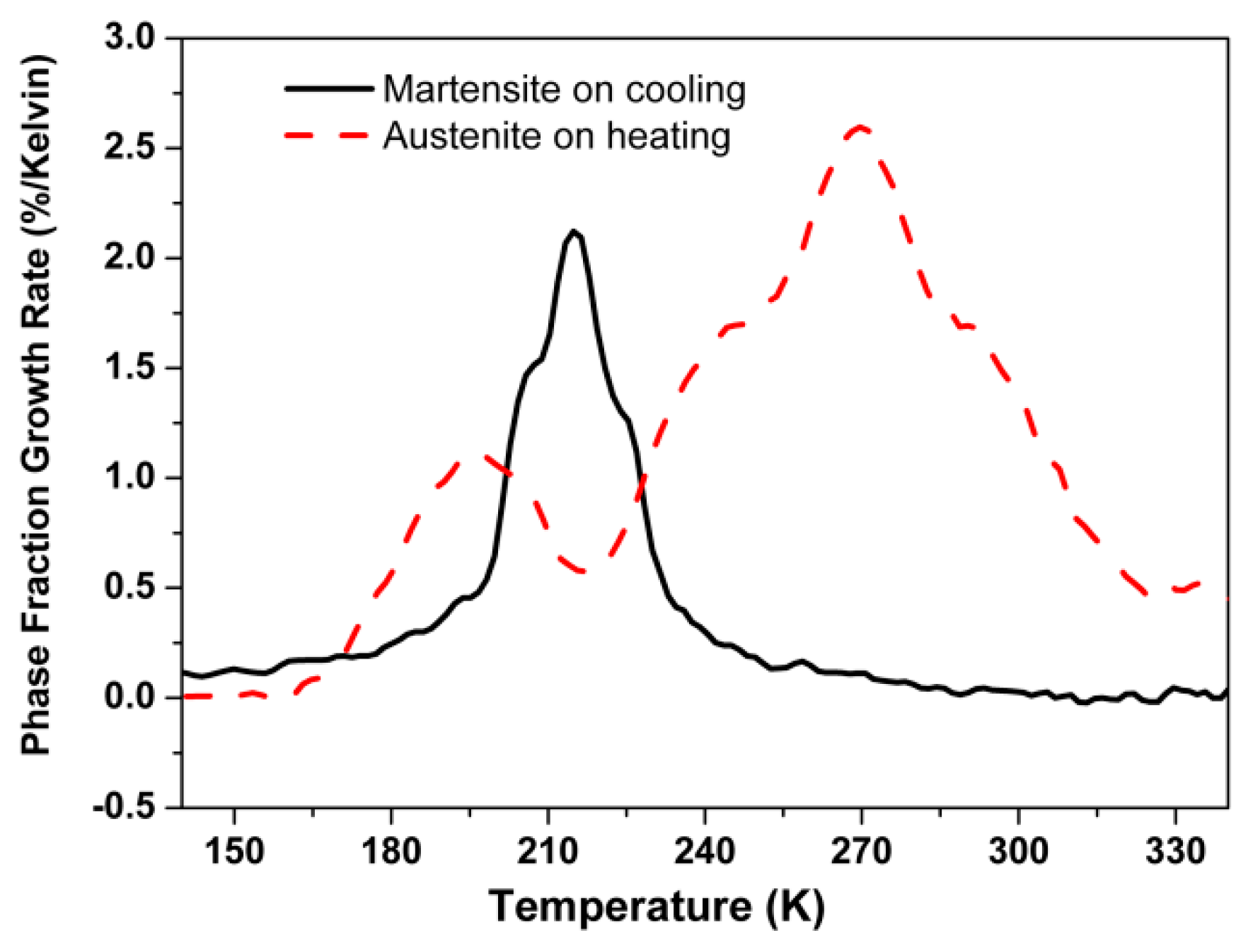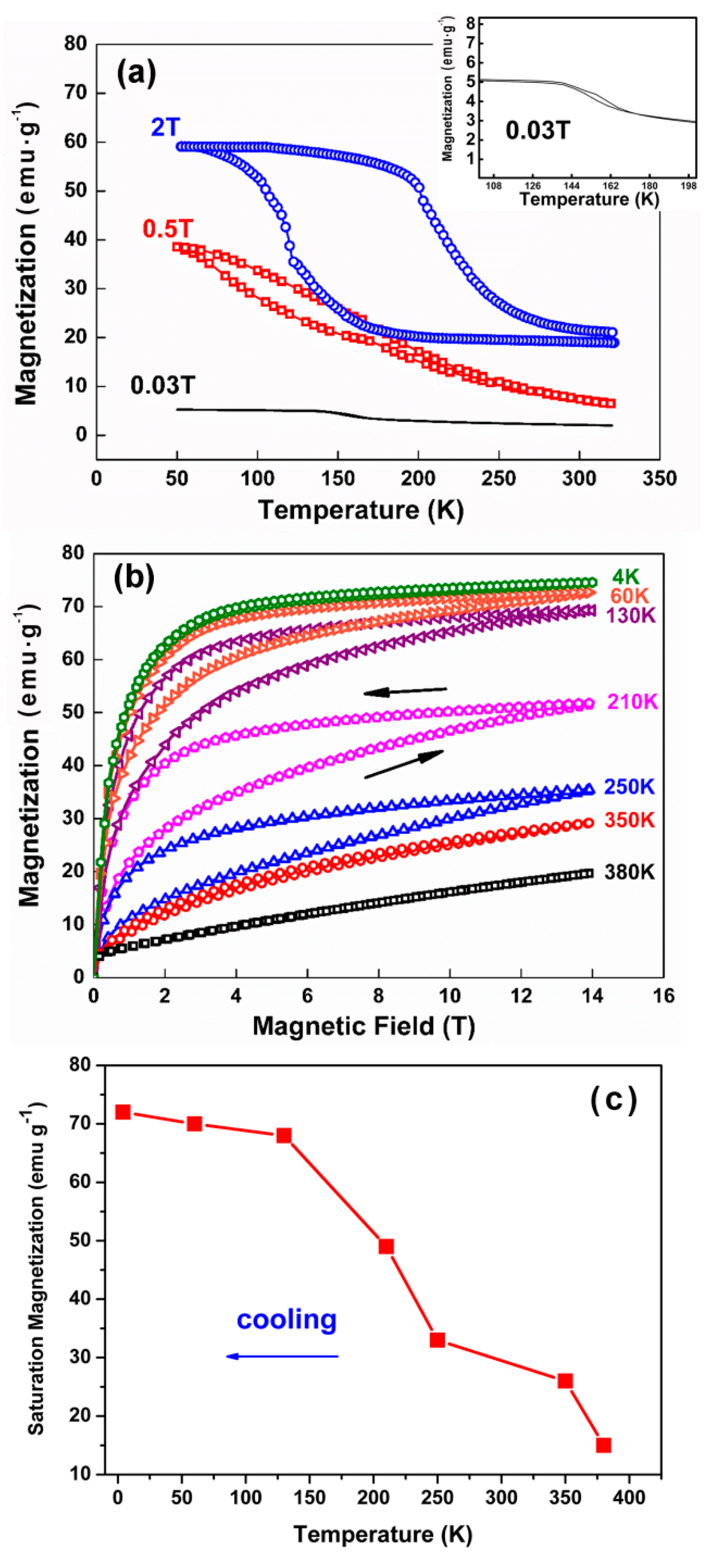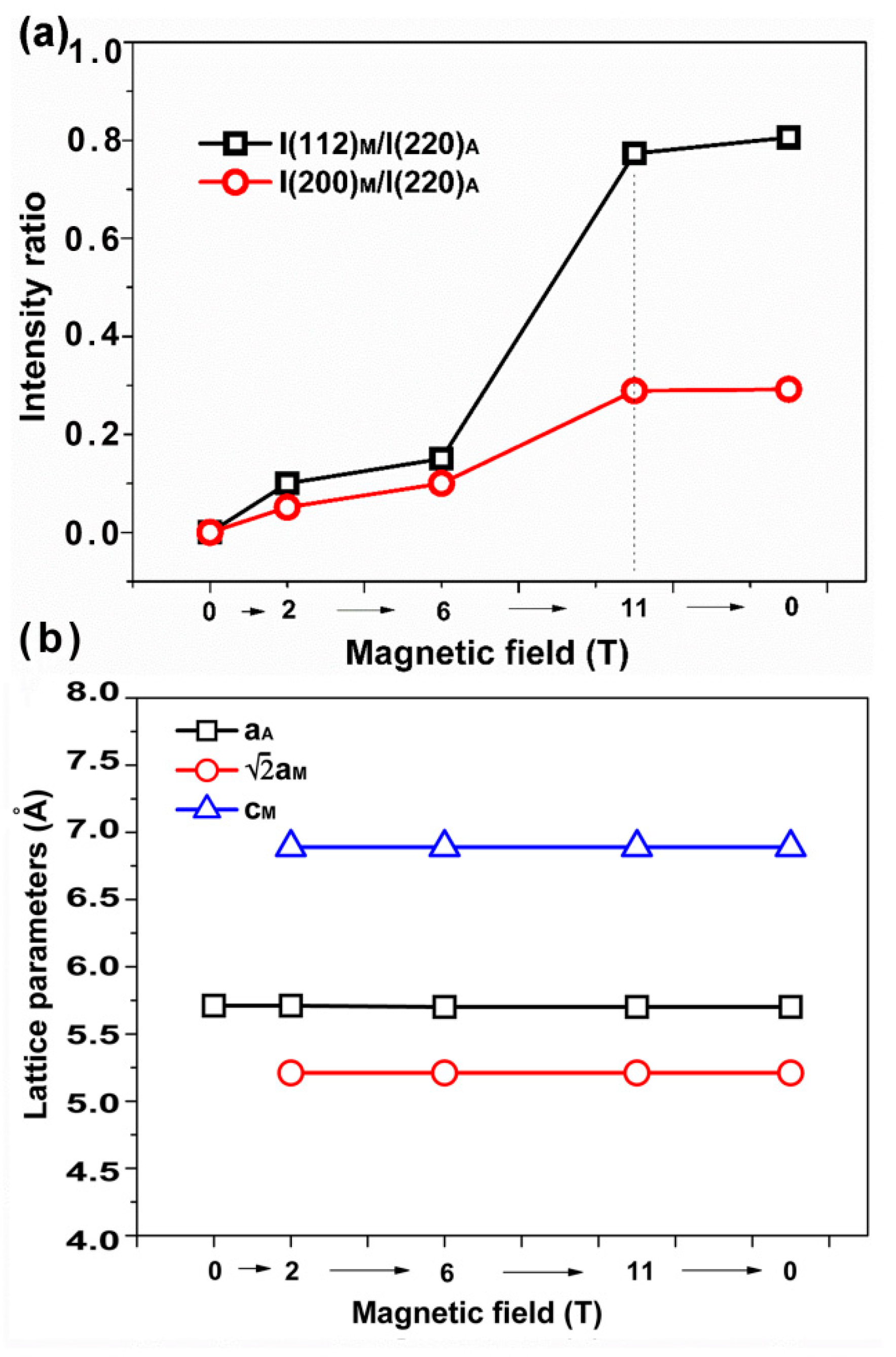In-Situ Study of Temperature- and Magnetic-Field-Induced Incomplete Martensitic Transformation in Fe-Mn-Ga
Abstract
:1. Introduction
2. Experimental Section
3. Results and Discussion
4. Conclusions
Author Contributions
Funding
Data Availability Statement
Acknowledgments
Conflicts of Interest
References
- Ullakko, K.; Huang, J.K.; Kantner, C.; O’handley, R.C.; Kokorin, V.V. Large magnetic-field-induced strains in Ni2MnGa single crystals. Appl. Phys. Lett. 1996, 69, 1966. [Google Scholar] [CrossRef]
- Kainuma, R.; Imano, Y.; Ito, W.; Sutou, Y.; Morito, H.; Okamoto, S.; Kitakami, O.; Oikawa, K.; Fujita, A.; Kanomata, T.; et al. Magnetic-field-induced shape recovery by reverse phase transformation. Nature 2006, 439, 957–960. [Google Scholar] [CrossRef]
- Saren, A.; Laitinen, V.; Vinogradova, M.; Ullakko, K. Twin boundary mobility in additive manufactured magnetic shape memory alloy 10M Ni-Mn-Ga. Acta Mater. 2023, 246, 118666. [Google Scholar] [CrossRef]
- Krenke, T.; Duman, E.; Acet, M.; Wassermann, E.F.; Moya, X.; Mañosa, L.; Planes, A.; Suard, E.; Ouladdiaf, B. Magnetic superelasticity and inverse magnetocaloric effect in Ni-Mn-In. Phys. Rev. B 2007, 75, 104414. [Google Scholar] [CrossRef] [Green Version]
- Bachaga, T.; Zhang, J.; Khitouni, M.; Sunol, J.J. NiMn-based Heusler magnetic shape memory alloys: A review. Int. J. Adv. Manuf. Technol. 2019, 103, 2761–2772. [Google Scholar] [CrossRef]
- Koyama, K.; Okada, H.; Watanabe, K.; Kanomata, T.; Kainuma, R.; Ito, W.; Oikawa, K.; Ishida, K. Observation of large magnetoresistance of magnetic Heusler alloy Ni50Mn36Sn14 in high magnetic fields. Appl. Phys. Lett. 2006, 89, 182510. [Google Scholar] [CrossRef]
- Yu, S.Y.; Ma, L.; Liu, G.D.; Liu, Z.H.; Chen, J.L.; Cao, Z.X.; Wu, G.H.; Zhang, B.; Zhang, X.X. Magnetic field-induced martensitic transformation and large magnetoresistance in NiCoMnSb alloys. Appl. Phys. Lett. 2007, 90, 242501. [Google Scholar] [CrossRef]
- Yang, J.; Li, Z.; Yang, B.; Yan, H.; Cong, D.; Zhao, X.; Zuo, L. Strain manipulation of magnetocaloric effect in a Ni39.5Co8.5Mn42Sn10 melt-spun ribbon. Scr. Mater. 2023, 224, 115141. [Google Scholar] [CrossRef]
- Khan, M.; Ali, N.; Stadler, S. Inverse magnetocaloric effect in ferromagnetic Ni50Mn37+xSb13-x Heusler alloys. J. Appl. Phys. 2007, 101, 053919. [Google Scholar] [CrossRef] [Green Version]
- Liu, J.; Gottschall, T.; Skokov, K.P.; Moore, J.D.; Gutfleisch, O. Giant magnetocaloric effect driven by structural transitions. Nat. Mater. 2012, 11, 620–626. [Google Scholar] [CrossRef]
- Zhang, B.; Zhang, X.X.; Yu, S.Y.; Chen, J.L.; Cao, Z.X.; Wu, G.H. Giant magnetothermal conductivity in the Ni-Mn-In ferromagnetic shape memory alloys. Appl. Phys. Lett. 2007, 91, 012510. [Google Scholar] [CrossRef]
- Li, Z.; Jing, C.; Chen, J.; Yuan, S.; Cao, S.; Zhang, J. Observation of exchange bias in the martensitic state of Ni50Mn36Sn14 Heusler alloy. Appl. Phys. Lett. 2007, 91, 112505. [Google Scholar] [CrossRef]
- Wang, B.M.; Liu, Y.; Ren, P.; Xia, B.; Ruan, K.B.; Yi, J.B.; Ding, J.; Li, X.G.; Wang, L. Large exchange bias after zero-field cooling from an unmagnetized state. Phys. Rev. Lett. 2011, 106, 077203. [Google Scholar] [CrossRef] [Green Version]
- Liu, J.; Woodcock, T.G.; Scheerbaum, N.; Gutfleisch, O. Influence of annealing on magnetic field-induced structural transformation and magnetocaloric effect in Ni-Mn-In-Co ribbons. Acta Mater. 2009, 57, 4911–4920. [Google Scholar] [CrossRef]
- Takagishi, M.; Koi, K.; Yoshikawa, M.; Funayama, T.; Iwasaki, H.; Sahashi, M. The applicability of CPP-GMR heads for magnetic recording. IEEE Trans. Magn. 2002, 38, 2277–2282. [Google Scholar] [CrossRef]
- Cong, D.Y.; Roth, S.; Schultz, L. Magnetic properties and structural transformations in Ni-Co-Mn-Sn multifunctional alloys. Acta Mater. 2012, 60, 5335–5351. [Google Scholar] [CrossRef]
- Omori, T.; Watanabe, K.; Xu, X.; Umetsu, R.Y.; Kainuma, R.; Ishida, K. Martensitic transformation and magnetic field-induced strain in Fe-Mn-Ga shape memory alloy. Scr. Mater. 2011, 64, 669–672. [Google Scholar] [CrossRef]
- Zhu, W.; Liu, E.K.; Feng, L.; Tang, X.D.; Chen, J.L.; Wu, G.H.; Liu, H.Y.; Meng, F.B.; Luo, H.Z. Magnetic-field-induced transformation in FeMnGa alloys. Appl. Phys. Lett. 2009, 95, 222512. [Google Scholar] [CrossRef]
- Yang, H.; Chen, Y.; Bei, H.; dela Cruz, C.R.; Wang, Y.D.; An, K. Annealing effects on the structural and magnetic properties of off-stoichiometric Fe-Mn-Ga ferromagnetic shape memory alloys. Mater. Des. 2016, 104, 327–332. [Google Scholar] [CrossRef] [Green Version]
- Zhang, Y.J.; Wu, Z.G.; Hou, Z.P.; Liu, Z.H.; Liu, E.K.; Xi, X.K.; Wang, W.H.; Wu, G.H. Magnetic-field-induced transformation and strain in polycrystalline FeMnGa ferromagnetic shape memory alloys with high cold-workability. Appl. Phys. Lett. 2021, 119, 142402. [Google Scholar] [CrossRef]
- Jenkins, C.A.; Scholl, A.; Kainuma, R.; Elmers, H.J.; Omori, T. Temperature-induced martensite in magnetic shape memory Fe2MnGa observed by photoemission electron microscopy. Appl. Phys. Lett. 2012, 100, 032401. [Google Scholar] [CrossRef] [Green Version]
- Ma, T.Y.; Liu, X.L.; Yan, M.; Wu, C.; Ren, S.; Li, H.Y.; Feng, M.X.; Qiu, Z.Y.; Ren, X.B. Suppression of martensitic transformation in Fe50Mn23Ga27 by local symmetry breaking. Appl. Phys. Lett. 2015, 106, 211903. [Google Scholar] [CrossRef]
- Tang, X.D.; Wang, W.H.; Zhu, W.; Liu, E.K.; Wu, G.H.; Meng, F.B.; Liu, H.Y.; Luo, H.Z. Giant exchange bias based on magnetic transition in γ-Fe2MnGa melt-spun ribbons. Appl. Phys. Lett. 2010, 97, 242513. [Google Scholar] [CrossRef]
- Tang, X.D.; Wang, W.H.; Wu, G.H.; Meng, F.B.; Liu, H.Y.; Luo, H.Z. Tuning exchange bias by thermal fluctuation in Fe52Mn23Ga25 melt-spun ribbons. Appl. Phys. Lett. 2011, 99, 222506. [Google Scholar] [CrossRef] [Green Version]
- Shih, C.W.; Zhao, X.G.; Chang, H.W.; Chang, W.C.; Zhang, Z.D. The phase evolution, magnetic and exchange bias properties in Fe50Mn24+xGa26-x (x = 0–3) melt-spun ribbons. J. Alloys Compd. 2013, 570, 14–18. [Google Scholar] [CrossRef]
- Sun, X.M.; Cong, D.Y.; Ren, Y.; Liss, K.-D.; Brown, D.E.; Ma, Z.Y.; Hao, S.J.; Xia, W.X.; Chen, Z.; Ma, L.; et al. Magnetic-field-induced strain-glass-to-martensite transition in a Fe-Mn-Ga alloy. Acta Mater. 2020, 183, 11. [Google Scholar] [CrossRef]
- Sun, X.M.; Cong, D.Y.; Ren, Y.; Brown, D.E.; Li, R.G.; Li, S.H.; Yang, Z.; Xiong, W.X.; Nie, Z.H.; Wang, L.; et al. Giant negative thermal expansion in Fe-Mn-Ga magnetic shape memory alloys. Appl. Phys. Lett. 2018, 113, 041903. [Google Scholar] [CrossRef]
- E04 Committee. Practice for X-ray Determination of Retained Austenite in Steel with Near Random Crystallographic Orientation; ASTM International: West Conshohocken, PA, USA, 2013. [Google Scholar]
- Studer, A.J.; Hagen, M.E.; Noakes, T.J. Wombat: The high-intensity powder diffractometer at the OPAL reactor. Phys. B Condens. Matter 2006, 385, 1013–1015. [Google Scholar] [CrossRef]
- Gallardo, M.C.; Manchado, J.; Romero, F.J.; del Cerro, J.; Salje, E.K.H.; Planes, A.; Vives, E.; Romero, R.; Stipcich, M. Avalanche criticality in the martensitic transition of Cu67.64Zn16.71Al15.65 shape-memory alloy: A calorimetric and acoustic emission study. Phys. Rev. B 2010, 81, 174102. [Google Scholar] [CrossRef] [Green Version]
- Soto-Parra, D.E.; Moya, X.; Mañosa, L.; Flores-Zúñiga, A.H.; Alvarado-Hernández, F.; Ochoa-Gamboa, R.A.; Matutes-Aquino, J.A.; Ríos-Jara, D. Fe and Co selective substitution in Ni2MnGa: Effect of magnetism on relative phase stability. Philos. Mag. 2010, 90, 2771–2792. [Google Scholar] [CrossRef] [Green Version]
- Yu, S.Y.; Liu, Z.H.; Liu, G.D.; Chen, J.L.; Cao, Z.X.; Wu, G.H.; Zhang, B.; Zhang, X.X. Large magnetoresistance in single-crystalline Ni50Mn50−xInx alloys (x = 14–16) upon martensitic transformation. Appl. Phys. Lett. 2006, 89, 162503. [Google Scholar] [CrossRef] [Green Version]
- Han, Z.D.; Wang, D.H.; Zhang, C.L.; Xuan, H.C.; Zhang, J.R.; Gu, B.X.; Du, Y.W. The phase transitions, magnetocaloric effect, and magnetoresistance in Co doped Ni-Mn-Sb ferromagnetic shape memory alloys. J. Appl. Phys. 2008, 104, 053906. [Google Scholar] [CrossRef]
- Sun, X.M.; Cong, D.Y.; Li, Z.; Zhang, Y.L.; Chen, Z.; Ren, Y.; Liss, K.-D.; Ma, Z.Y.; Li, R.G.; Qu, Y.H.; et al. Manipulation of magnetostructural transition and realization of prominent multifunctional magnetoresponsive properties in NiCoMnIn alloys. Phys. Rev. Mater. 2019, 3, 034404. [Google Scholar] [CrossRef]
- Sharma, V.K.; Chattopadhyay, M.K.; Shaeb, K.H.B.; Chouhan, A.; Roy, S.B. Large magnetoresistance in Ni50Mn34In16 alloy. Appl. Phys. Lett. 2006, 89, 222509. [Google Scholar] [CrossRef]
- Huang, X.M.; Zhao, Y.; Yan, H.L.; Jia, N.; Yang, B.; Li, Z.; Zhang, Y.; Esling, C.; Zhao, X.; Zuo, L. Giant magnetoresistance, magnetostrain and magnetocaloric effects in a Cu-doped<001>-textured Ni45Co5Mn36In13.2Cu0.8 polycrystalline allo. J. Alloys Compd. 2021, 889, 161652. [Google Scholar]
- Zheng, T.T.; Liu, K.; Chen, H.X.; Wang, C. Large magnetocaloric and magnetoresistance effects during martensitic transformation in Heusler-type Ni44Co6Mn37In13 alloy. J. Magn. Magn. Mater. 2022, 563, 170034. [Google Scholar] [CrossRef]
- Huang, L.; Cong, D.Y.; Ma, L.; Nie, Z.H.; Wang, M.G.; Wang, Z.L.; Suo, H.L.; Ren, Y.; Wang, Y.D. Large magnetic entropy change and magnetoresistance in a Ni41Co9Mn40Sn10 magnetic shape memory alloy. J. Alloys Compd. 2015, 647, 1081–1085. [Google Scholar] [CrossRef] [Green Version]
- Karaca, H.E.; Karaman, I.; Basaran, B.; Ren, Y.; Chumlyakov, Y.I.; Maier, H.J. Magnetic field-induced phase transformation in NiMnCoIn magnetic shape-memory alloys-a new actuation mechanism with large work output. Adv. Funct. Mater. 2009, 19, 983–998. [Google Scholar] [CrossRef]
- Nayak, A.K.; Suresh, K.G.; Nigam, A.K. Giant inverse magnetocaloric effect near room temperature in Co substituted NiMnSb Heusler alloys. J. Phys. D Appl. Phys. 2009, 42, 035009. [Google Scholar] [CrossRef] [Green Version]
- Monroe, J.A.; Karaman, I.; Basaran, B.; Ito, W.; Umetsu, R.Y.; Kainuma, R.; Koyama, K.; Chumlyakov, Y.I. Direct measurement of large reversible magnetic-field-induced strain in Ni-Co-Mn-In metamagnetic shape memory alloys. Acta Mater. 2012, 60, 6883–6891. [Google Scholar] [CrossRef]
- Roca, P.L.; López-García, J.; Sánchez-Alarcosa, V.; Recartea, V.; Rodríguez-Velamazáne, J.A.; Pérez-Landazábal, J.I. Room temperature huge magnetocaloric properties in low hysteresis ordered Cu-doped Ni-Mn-In-Co alloys. J. Alloys Compd. 2022, 922, 166143. [Google Scholar] [CrossRef]
- Recarte, V.; Pérez-Landazábal, J.I.; Sánchez-Alarcos, V.; Zablotskii, V.; Cesari, E.; Kustov, S. Entropy change linked to the martensitic transformation in metamagnetic shape memory alloys. Acta Mater. 2012, 60, 3168–3175. [Google Scholar] [CrossRef]
- Lázpita, P.; Pérez-Checa, A.; Barandiarán, J.M.; Ammerlaan, A.; Zeitler, U.; Chernenko, V. Suppression of martensitic transformation in Ni-Mn-In metamagnetic shape memory alloy under very strong magnetic field. J. Alloys Compd. 2021, 874, 159814. [Google Scholar] [CrossRef]
- Salas, D.; Wang, Y.; Duong, T.C.; Attari, V.; Ren, Y.; Chumlyakov, Y.; Arróyave, R.; Karaman, I. Competing interactions between mesoscale length-scales, order-disorder, and martensitic transformation in ferromagnetic shape memory alloys. Acta Mater. 2021, 206, 116616. [Google Scholar] [CrossRef]
- Salazar-Mejía, C.; Devi, P.; Singh, S.; Felser, C.; Wosnitza, J. Influence of Cr substitution on the reversibility of the magnetocaloric effect in Ni-Cr-Mn-In Heusler alloys. Phys. Rev. Mater. 2021, 5, 104406. [Google Scholar] [CrossRef]
- Kainuma, R.; Ito, W.; Umetsu, R.Y.; Oikawa, K.; Ishida, K. Magnetic field-induced reverse transformation in B2-type NiCoMnAl shape memory alloys. Appl. Phys. Lett. 2008, 93, 091906. [Google Scholar] [CrossRef]
- Ahadi, A.; Sun, Q. Effects of grain size on the rate-dependent thermomechanical responses of nanostructured superelastic NiTi. Acta Mater. 2014, 76, 186–197. [Google Scholar] [CrossRef]
- Omori, T.; Nagasako, M.; Okano, M.; Endo, K.; Kainuma, R. Microstructure and martensitic transformation in the Fe-Mn-Al-Ni shape memory alloy with B2-type coherent fine particles. Appl. Phys. Lett. 2012, 101, 231907. [Google Scholar] [CrossRef]
- Bhattacharyya, S.; Jinschek, J.R.; Li, J.F.; Viehland, D. Nanoscale precipitates in magnetostrictive Fe1-xGax alloys for 0.1 < x < 0.23. J. Alloys Compd. 2010, 501, 148–153. [Google Scholar]
- Khachaturyan, A.G.; Viehland, D. Structurally heterogeneous model of extrinsic magnetostriction for Fe-Ga and similar magnetic alloys: Part I. decomposition and confined displacive transformation. Metall. Mater. Trans. A 2007, 38A, 2308–2316. [Google Scholar]
- Hane, K.F.; Shield, T.W. Microstructure in the cubic to monoclinic transition in titanium-nickel shape memory alloys. Acta Mater. 1999, 47, 2603–2617. [Google Scholar] [CrossRef]
- Song, Y.T.; Chen, X.; Dabade, V.; Shield, T.W.; James, R.D. Enhanced reversibility and unusual microstructure of a phase-transforming material. Nature 2013, 502, 85–88. [Google Scholar] [CrossRef]
- Sun, X.M.; Cong, D.Y.; Ren, Y.; Brown, D.E.; Gallington, L.C.; Li, R.G.; Cao, Y.X.; Chen, Z.; Li, S.H.; Nie, Z.H.; et al. Enhanced negative thermal expansion of boron-doped Fe43Mn28Ga28.97B0.03 alloy. J. Alloys Compd. 2021, 857, 157572. [Google Scholar] [CrossRef]







Disclaimer/Publisher’s Note: The statements, opinions and data contained in all publications are solely those of the individual author(s) and contributor(s) and not of MDPI and/or the editor(s). MDPI and/or the editor(s) disclaim responsibility for any injury to people or property resulting from any ideas, methods, instructions or products referred to in the content. |
© 2023 by the authors. Licensee MDPI, Basel, Switzerland. This article is an open access article distributed under the terms and conditions of the Creative Commons Attribution (CC BY) license (https://creativecommons.org/licenses/by/4.0/).
Share and Cite
Sun, X.; Cui, J.; Li, S.; Ma, Z.; Liss, K.-D.; Li, R.; Chen, Z. In-Situ Study of Temperature- and Magnetic-Field-Induced Incomplete Martensitic Transformation in Fe-Mn-Ga. Crystals 2023, 13, 1242. https://doi.org/10.3390/cryst13081242
Sun X, Cui J, Li S, Ma Z, Liss K-D, Li R, Chen Z. In-Situ Study of Temperature- and Magnetic-Field-Induced Incomplete Martensitic Transformation in Fe-Mn-Ga. Crystals. 2023; 13(8):1242. https://doi.org/10.3390/cryst13081242
Chicago/Turabian StyleSun, Xiaoming, Jingyi Cui, Shaofu Li, Zhiyuan Ma, Klaus-Dieter Liss, Runguang Li, and Zhen Chen. 2023. "In-Situ Study of Temperature- and Magnetic-Field-Induced Incomplete Martensitic Transformation in Fe-Mn-Ga" Crystals 13, no. 8: 1242. https://doi.org/10.3390/cryst13081242








